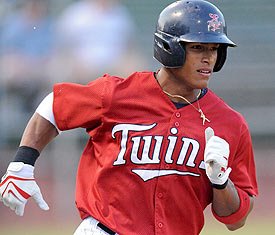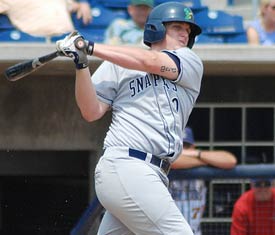November 4, 2008
Twins 2008 Minor League Numbers: Hitters
Before getting to the good stuff, please note that these are not my rankings of the Twins' top prospects. That annual list will be published later this offseason and includes both multi-year track records and long-term potential as huge factors, whereas the numbers below focus solely on what each player did this year. The point here is to simply determine who had the best 2008 season by putting everyone's numbers through the same context-adjusting system.
The first step is taking raw numbers and adjusting them for run-scoring environments, with the idea being that everyone should first be placed on an even playing field before evaluating their performance. For example, catching prospect Wilson Ramos hit .288/.346/.434 in 126 games for Fort Myers at high Single-A, which looks relatively mediocre at first glance. However, the Florida State League as a whole batted just .256/.329/.376 while scoring 8.5 combined runs per game in 2008.
The run-scoring environment that Ramos played in this year was almost 10 percent worse for offense than MLB, which is a major part of his unspectacular numbers. Once you normalize the Florida State League to fit the level of offense found in MLB, then Ramos' hitting line improves to .297/.350/.480, which is extremely impressive from a 20-year-old catcher (the average MLB catcher hit .257/.325/.390 in 2008) and does a far better job of showing his outstanding potential than the raw numbers.
Because the Twins' minor-league system is filled with teams playing in low run-scoring environments, normalizing the organization-wide hitting numbers causes most position players to get a Ramos-like boost. Putting hitting prospects in leagues where the average team doesn't even slug .400 will do a lot to skew the perception of their ability and that's the case throughout the Twins' system. Here are the top adjusted 2008 hitting lines from Twins minor leaguers with 200-plus trips to the plate:
PA AVG OBP SLG OPS
Angel Morales 218 .303 .415 .670 1.085
Ben Revere 374 .397 .448 .557 1.005
Evan Bigley 236 .302 .362 .631 .993
Aaron Hicks 204 .332 .411 .574 .985
Jonathan Waltenbury 293 .321 .384 .580 .964
Chris Parmelee 289 .250 .398 .556 .954
Brian Buscher 214 .320 .404 .529 .933
Randy Ruiz 456 .321 .368 .552 .920
Luke Hughes 436 .310 .366 .543 .909
Danny Valencia 538 .316 .365 .535 .900
Alejandro Machado 215 .339 .378 .486 .864
Steven Tolleson 397 .300 .376 .481 .857
Steve Singleton 536 .309 .369 .488 .857
Michael Harrington 276 .268 .357 .486 .843
Garrett Jones 587 .280 .339 .498 .837
Whit Robbins 346 .276 .388 .448 .836
Rene Leveret 244 .301 .370 .464 .834
Wilson Ramos 500 .297 .350 .480 .830
Daniel Ortiz 205 .286 .330 .490 .820
Nicholas Romero 222 .276 .340 .475 .815
Dustin Martin 573 .290 .350 .461 .811
Edward Ovalle 509 .293 .355 .456 .811
Daniel Berg 317 .283 .375 .436 .811
Dominic de la Osa 284 .265 .386 .424 .810
Matt Macri 350 .260 .325 .480 .805
Ben Revere got most of the attention by flirting with .400 for much of the year, but on a per-game basis Angel Morales was actually the Twins' best minor-league hitter this season. Despite being 18 months younger than Revere and six months younger than 2008 first-round pick Aaron Hicks, Morales batted .301/.413/.623 in 54 games at short-season Elizabethton, leading the rookie-level Appalachian League in homers and slugging percentage.
Morales' numbers are plenty great on their own, but become even better after accounting for the fact that the Appalachian League as a whole hit .262/.331/.387. Slugging .623 in an environment where the average slugging percentage was a measly .387 is equivalent to slugging .670 in an environment with MLB-level offense. Morales' breakout consists of just 218 plate appearances, so there are sample-size issues at play, but an 18-year-old posting an adjusted hitting line of .303/.415/.670 is pretty sick.
 Of course, Revere wasn't bad himself. He came up short of the .400 mark by hitting "only" .379, but after accounting for the pitcher-friendly Midwest League his adjusted batting average jumps to .397. Morales and Revere were the only hitters in the system to post an adjusted OPS above 1.000 and Hicks ranked fourth at .985, which is amazing from a trio of center fielders selected out of high school in the past two drafts. Here are the top adjusted Isolated Power and Isolated Discipline marks:
Of course, Revere wasn't bad himself. He came up short of the .400 mark by hitting "only" .379, but after accounting for the pitcher-friendly Midwest League his adjusted batting average jumps to .397. Morales and Revere were the only hitters in the system to post an adjusted OPS above 1.000 and Hicks ranked fourth at .985, which is amazing from a trio of center fielders selected out of high school in the past two drafts. Here are the top adjusted Isolated Power and Isolated Discipline marks:
IsoP IsoD
Angel Morales .367 Chris Parmelee .148
Evan Bigley .329 Dominic de la Osa .121
Chris Parmelee .306 Allan De San Miguel .119
Jonathan Waltenbury .259 Angel Morales .112
Aaron Hicks .242 Whit Robbins .112
Luke Hughes .233 Johnny Woodard .102
Randy Ruiz .231 James Beresford .099
Matt Macri .220 Daniel Berg .092
Danny Valencia .219 Michael Harrington .089
Michael Harrington .218 Daniel Lehmann .088
Garrett Jones .218 Brian Buscher .084
David Winfree .213 Drew Butera .084
Brian Buscher .209 Tommy Watkins .082
Daniel Ortiz .204 Toby Gardenhire .080
Ramon Santana .201 Aaron Hicks .079
Erik Lis .200 Brian Dinkelman .079
Based solely on his .239 batting average you'd conclude that 2006 first-round pick Chris Parmelee had a horrible season, but that's far from the case. Parmelee hitting just .239 this season and .246 for his minor-league career certainly isn't a good thing and raises big questions about his long-term potential, but focusing strictly on that overlooks great power and plate discipline. Only Morales and Evan Bigley displayed more raw power than Parmelee, and no one in the Twins' system had more patience.
Despite batting just .239, Parmelee posted an adjusted .250/.398/.556 line that ranks as the sixth-best production from any hitter in the Twins' system. To put Parmelee's power in perspective, consider that he played alongside Revere at Beloit and they posted slugging percentages within one point of each other (.497 versus .496) despite a 140-point gap in the batting average (.379 versus .239). Unlike most guys in the system Parmelee has the secondary skills to make a big impact without a big average.
 All of the above numbers have been adjusted for run-scoring environments, but further adjustments for ages and defensive positions are also important. For example, Garrett Jones' adjusted .280/.339/.498 line looks pretty good and ranked as the 15th-best among the system's hitters, but his .837 adjusted OPS ceases looking so great given that he was a 27-year-old first baseman playing his fourth straight season at Triple-A. In fact, for a 27-year-old first baseman at Triple-A that's far from impressive.
All of the above numbers have been adjusted for run-scoring environments, but further adjustments for ages and defensive positions are also important. For example, Garrett Jones' adjusted .280/.339/.498 line looks pretty good and ranked as the 15th-best among the system's hitters, but his .837 adjusted OPS ceases looking so great given that he was a 27-year-old first baseman playing his fourth straight season at Triple-A. In fact, for a 27-year-old first baseman at Triple-A that's far from impressive.
Meanwhile, Ramos and Jones essentially had identical adjusted hitting lines, but an .830 OPS from a 20-year-old catcher facing older competition at high Single-A is vastly more impressive than an .837 OPS from a 27-year-old first baseman facing younger competition during his fourth crack at Triple-A. Ramos' season suggests that he has the potential to develop into a good-hitting everyday catcher in the majors. Jones' season suggests that he has the potential to spend another few years at Triple-A.
Attempting to compare players like Ramos to players like Jones shows the importance of the next step, which is making further adjustments for age and defensive position. In other words, how does each player's offense compare to other players at his position, and how old was each player relative to the level he was at and prospects he was playing against. If you take the normalized numbers above and apply further adjustments based on age and position, you get the following:
AGE LEVEL POS OPS%
Angel Morales 18 RK+ CF 1.60
Ben Revere 20 A- CF 1.41
Aaron Hicks 18 RK- CF 1.38
Wilson Ramos 20 A+ C 1.27
Chris Parmelee 20 A- 1B 1.23
Luke Hughes 23 AA/AAA 3B 1.21
Evan Bigley 21 RK+ LF 1.19
Jonathan Waltenbury 20 RK+ 1B 1.19
Steven Tolleson 24 AA SS 1.15
Danny Valencia 23 A+/AA 3B 1.14
Steve Singleton 22 A-/A+ 2B 1.11
Daniel Ortiz 18 RK- RF 1.09
Trevor Plouffe 22 AA/AAA SS 1.09
Brian Buscher 27 AAA 3B 1.08
Joe Benson 20 A- CF 1.07
Nicholas Romero 20 RK+ 3B 1.06
Alejando Machado 26 AAA 2B 1.06
Jose Morales 25 AAA C 1.06
Allan De San Miguel 20 A-/A+ C 1.06
Ramon Santana 22 A- SS 1.04
Matt Macri 26 AAA SS 1.04
Edward Ovalle 23 A+ CF 1.04
Dustin Martin 24 AA CF 1.03
David Winfree 22 AA RF 1.03
Jason Pridie 24 AAA CF 1.00
After factoring in leagues, run-scoring environments, defensive positions, and age, the Twins' system had 25 players who were above-average offensively in 2008. Morales led the way at 60 percent above average, followed by Revere at 41 percent and Hicks at 38 percent. Ramos led the non-center fielders at 27 percent above par (whereas Jones doesn't even crack the list) and Parmelee's mostly overlooked season rounds out the top five at 23 percent better than average.
Among players who've advanced past Single-A, Luke Hughes led the way at 21 percent above average, followed by Steven Tolleson at 15 percent and Danny Valencia at 14 percent. That trio represents the closest thing the Twins have to good, MLB-ready hitting prospects and they were joined in the top 10 by rookie-ball standouts Bigley and Jonathan Waltenbury at 19 percent above average. Incidentally, with enough plate appearances to qualify Denard Span would have ranked fifth at 24 percent above par.
Once you're done here, check out my latest "Daily Dose" column over at Rotoworld.

